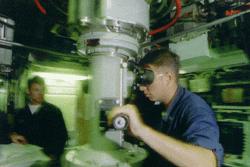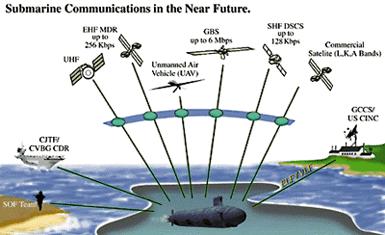by Jacob Longacre, Gerald Exley,
and Craig McMillan
It has begun to transform itself from a
“Silent Service” – with a tradition of
operating independently – into a full participant in
Network-Centric Warfare. With networked computers linked
together by a variety of communications paths, submarines
will soon be able to transmit and receive information at
unprecedented rates. The Navy needs these new
capabilities to establish information superiority over
future adversaries as a major factor in achieving
battlespace dominance.
A key element in this new architecture is
the Submarine Communications Support System (SCSS), which
adapts Navy-wide communications components and
capabilities, while minimizing dependence on
submarine-unique equipment. The SCSS will use
industry-standard protocols and commercial technology in
hardware ruggedized for the rigors of the shipboard
environment. Its architecture will phase out today’s
“stovepipe” systems to implement a
client-server environment for exchanging information by
means of seamless and comprehensive connectivity on
shared, common-user communication links.
Vision and Roles
The Navy’s Network-Centric Warfare vision relies on
sharing information to gain both strategic and tactical
advantage. Information Technology for the 21st Century
(IT-21) is the key initiative for creating the global
information infrastructure required by that vision. For
the submarine force to be a capable player in
Network-Centric Warfare, it will need to be a full
participant in the underlying information networks that
enable interoperability with Joint forces. These networks
will provide not only the Common Operational Picture
(COP) for force coordination, but also the
information-handling capabilities the warfighter needs to
make better-informed decisions, execute cooperative
engagements, allocate forces more effectively, and reduce
tactical response times. The network will also transfer
intelligence, weather, logistics, and disbursing
information to improve operational effectiveness, as well
as personal e-mail for better quality of life. For the
submarine, the price of admission is a new communications
infrastructure to support orders-of-magnitude more data
than is possible even today. This infrastructure includes
the antennas, transceivers, internal switching, system
control, and data distribution elements that will
facilitate submarine communications comparable to those
of large surface combatants. Further, submarines must
achieve these new capabilities without compromising their
inherent stealth.
A New Age of Connectivity
The next decade will produce major changes in submarine
communications. Increases in data rate, changes in the
number and type of links supported, the use of link
protocols that allow efficient sharing of the Radio
Frequency (RF) spectrum, and improved traffic handling
are all under development by the Space and Naval Warfare
Systems Command (SPAWAR).
Antenna Developments
The greatest technical challenge facing submarine
communications is fielding antennas capable of the high
data rates future broadcast circuits will require.
Current plans call for phasing out the current AN/BRA-34s
in favor of two new antennas: the OE-538 Multi-Function
Mast and the submarine High Data Rate (HDR) antenna. The
OE-538 will cover all the bands of today’s
AN/BRA-34, including Identification Friend or Foe (IFF)
and Global Positioning System (GPS), add broadband HF,
VHF, and L-band UHF for Link 16, and provide significant
reliability improvements. The submarine HDR
antenna/terminal features a 16-inch dish antenna, capable
of satellite data rates ranging from 128 Kilobits per
second (kbps) to 8 megabits per second (Mbps). It will
access EHF Low Data Rate/Medium Data Rate (LDR/MDR)
transmissions, SHF, and the Global Broadcast Service
(GBS).
Further into the future, the next
generation of submarine communication masts will be
configured as multi-function, broadband antenna systems.
They will incorporate electronic support measures (ESM)
and offer sufficient aperture and gain to close the
satellite links needed for sending and receiving imagery
and other high-data-rate traffic.
To gain full benefit from tomorrow’s
information infrastructure, the periodic and intermittent
nature of traditional submarine connectivity must be
supplanted, itself a major change in the way submarines
do business. Fundamentally, this requires improving the
submarine’s ability to communicate at depth.
Submarines will still be able to receive bellringer and
short emergency messages throughout most of their speed
and depth envelope, but additional capabilities will be
added. With the introduction of ELF on-hull antennas and
enhanced-data-rate ELF transmissions, submarines will
soon be able to receive ELF messages with fewer operating
constraints. Also, the Advanced Buoyant Cable Antenna
(ABCA), currently an Advanced Technology Demonstration,
will allow two-way UHF satellite communications with
submarines at depth, to rates of tens of kilobits per
second or greater, and with UHF line-of-sight capability
to more than 1.5 Mbps. Short-range communications between
submarines, from submarines to unmanned undersea
vehicles, and from submarines to surface ships will also
be possible at depth using advanced underwater acoustic
communications. This will provide data rates of several
kbps over tens of nautical miles. The ultimate goal is to
develop an RF and acoustic communications network for
linking undersea forces seamlessly with each other and
with air and surface units.
Network-Centric
Warfare
Using primarily space-based systems, we will
create what I like to call a battlefield
internet. Our ships, planes, subs, and Marines
— will essentially log on to this internet
and be able to achieve incredibly deep
situational awareness because of the information
power contained on this internet grid.
Additionally, naval or joint force commanders
will have increased visibility across the
spectrum of assets available to them, giving them
incredible flexibility to match targets to
weapons and delivery platforms. We call this new
way of thinking and fighting “Network-Centric
Warfare," and it's a term you'll hear a lot
in the future.
Admiral Jay L. Johnson
Chief of Naval Operations
|
Internal Information
Distribution
To take full advantage of these advances in external
submarine communications, corresponding enhancements in
on-board information processing and distribution are
needed. The Submarine Communications Program Office
(SPAWAR PMW173) is working with the Joint Maritime
Communications Strategy (JMCOMS) Program Office (SPAWAR
PMW176) to adapt the Advanced Digital Network System
(ADNS) to submarines. ADNS integrates packet switching,
Internet-Protocol message routing, and centralized
equipment control functions into a suite of Navy-standard
components. Operator aids and software automation will
streamline the implementation of communication plans,
simplify routine operations, and reduce manual
maintenance requirements. Similarly, the submarine-unique
equipment currently used for message processing will soon
be replaced by a message handler based on commercial
subsystems and incorporate automatic header recognition
and integrated traffic management, as well as archiving
and text processing.

The Undersea Network: A Future Vision
The transformation of today’s
submarine radio room will occur incrementally over the
next decade. During this time, the radio room will be
automated increasingly for distribution of both baseband
and RF signals. For RF, the Submarine Antenna
Distribution System (SADS) will provide automatic
switching and routing, as well as antenna system control
and signal conditioning. SADS will be operated from a
computer workstation that eliminates manual patch panels.
Correspondingly, the Submarine Baseband Circuit Switch
(SBCS) will use processor control to route baseband
signals, as a major step toward achieving a fully
automated radio room that can be operated from a
workstation located either in the radio room itself or in
the ship’s control spaces.
Affordability
In this era of diminishing defense budgets, the
affordability of new systems is a key issue. These new
communication systems minimize up-front investment by
leveraging commercial telecommunications research and
technology to the fullest extent possible, particularly
in the areas of baseband equipment, data compression
techniques, and satellite services. Off-the-shelf and
Navy-common and Joint hardware and software will be
employed extensively, tailored for submarine applications
when necessary. The use of an open architecture will
allow subsystems to be upgraded easily with
state-of-the-art commercial components. Additionally, the
automation of both routine operations and the preparation
of communication plans, as well as paperless message
distribution, will reduce the cost of training and
manning.
Submarine
Mast Antenna Progression

From right to left: OE-538
Multi-functional Mast, HDR Antenna, SHF Phased Array
Antenna ATD, and Future Antenna Conceptual Designs
Impact on Future Submarine
Operations
When fully realized, the enhancements now in development
will integrate the Submarine Force more closely than ever
into the mainstream of Fleet operations and permit the
submarine to operate as a fully-connected member of the
Battle Group. This will dramatically enlarge the
submarine’s already central role in coordinated
undersea warfare, and will improve its already robust
capabilities in Intelligence, Surveillance, and
Reconnaissance (ISR), land attack, and power projection
ashore. This revolutionary connectivity will be central
to the ability to respond rapidly to calls for fire from
ashore and to participate in cooperative engagements with
surface, air, and land assets. Over-the-horizon ISR with
offboard sensors on unmanned underwater vehicles and
unmanned aerial vehicles will become routine. With the
submarine then able to act as a full participant in the
Network-Centric Warfare envisioned for the Navy’s
future, its former days as a “Lone Ranger”
– “out of sight and out of mind” –
will be over.
EHF
Antenna Links Attack Subs More
Closely to Carrier Battle Groups
ABOARD USS PASADENA OFF HAWAII —
Earlier this year, the USS Pasadena
(SSN-752) received a communications upgrade that
will make integrated battle group operations a
reality. "It’s been working great. It’s
an awesome system," said Chief Petty Officer
Bob Esselborn, an electronics technician aboard Pasadena.
The AN/USC-38 antenna system, which consists
of a 5 1/4-inch steerable dish antenna on one of
the submarine’s periscopes, uses the
extremely high frequency (EHF) band for
transmission. The sub’s crew can control the
antenna to acquire a communications satellite to
transmit a message directly to the aircraft
carrier. The EHF beam is “focused,” and
thus hard for enemy sensors to pick up, Esselborn
added.
Such an EHF system is particularly important
at a time when the Navy’s attack submarines
are working more closely with their carrier
battle groups, rather than autonomously. Over
half of today’s SSN fleet is equipped with
this system. The EHF antenna can also benefit the
boat in shooting Tomahawk land attack missiles at
mobile targets, including missile launchers.
“We get updates more quickly and accurately,
allowing us to execute our tasking faster,”
CDR Scott VanBuskirk, the Pasadena’s
skipper, said of the USC-38 system. “It’s
reliable, hard to detect, and hard to jam.”
The Pasadena is assigned to the USS Carl
Vinson (CVN-70) battle group, which is
scheduled to deploy this fall to the Western
Pacific.

A USS Pasadena (SSN-752) sailor looks for
contacts on the Type 8 periscope during joint
exercise RIMPAC 98. Mounted atop the
scope is a steerable satellite communication
dish capable of stealthy and reliable
communications directly with the carrier
battle group.
Based on an article by Frank Wolfe in Defense
Daily of 21 July 1998. Reprinted with permission
from Phillips Business Information, Inc. (phone:
1-800-777-5006, fax: 301-309-3847, e-mail:
[email protected]). For full text
of this article, please see PBI’s Defense
Daily Network web site at www.defensedaily.com.
|
—
The authors are scientists and engineers in the Submarine
Electromagnetic Department at the Naval Undersea Warfare
Center/Newport Division.
|




